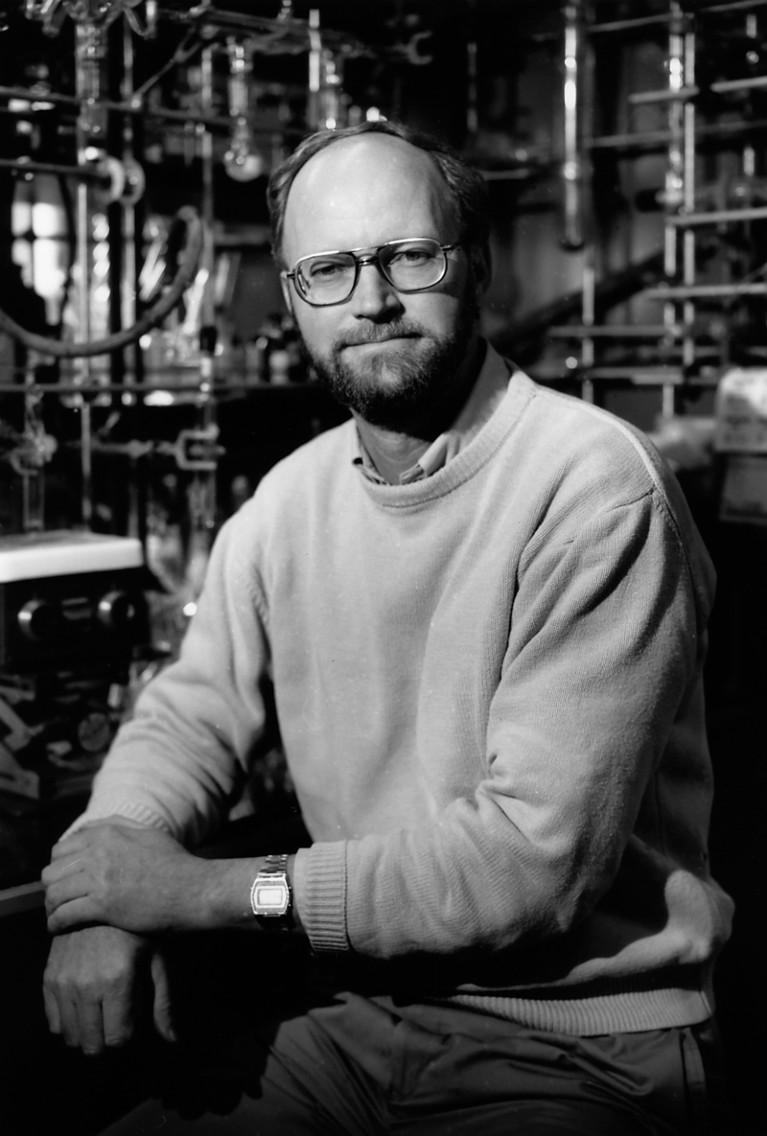
Credit: Caltech
In multiple branches of chemistry, Robert Grubbs combined a delight in discovery with a keen focus on applications. His organometallic catalysts transformed synthetic chemistry, polymer science, advanced materials science and pharmaceuticals. Grubbs shared the 2005 Nobel Prize in Chemistry with Richard Schrock and Yves Chauvin. He has died aged 79.
Grubbs’s best-known work was on a reaction that breaks and reforms the connections between carbon atoms in hydrocarbons: olefin metathesis. It is like a dance. A metal atom holding both hands with a carbon atom approaches two carbon atoms holding both hands. They form a ring and then change partners, with each atom now bound to a new one. The reaction of a metal–carbon double bond with a carbon–carbon double bond breaks two bonds and forms two new bonds in one step.
Creation of new bonds is fundamental to the synthesis of molecules, whether small molecules used in pharmaceuticals or very large ones used in advanced materials such as television screens. The carbon–carbon double bond is often an important component of the chemical functionality that allows small molecules or polymers to be transformed into more complex ones. Metathesis, in its ability to generate new carbon–carbon double bonds, has become a powerful technique in many fields.
Grubbs made major contributions to polymer science. Using olefin metathesis, he was able to build complex polymers — chains of identical subunits that form the basis of plastics and other synthetic materials. Controlling the molecular weights and shapes of polymers, he could induce them to self-assemble into higher-order structures, or engineer them for drug delivery. Others have used some of his strategies to develop self-healing materials, among myriad other polymers.
Grubbs was born near Possum Trot, a rural community in western Kentucky. His mother taught in schools and his father was a mechanic. He began his career at the University of Florida in Gainesville, where organic chemist Merle Battiste persuaded him to switch from agricultural science. He studied thermal rearrangements of cyclopropenes, rings of three carbon atoms that contain a lot of energy because their bonds are under strain. His fascination with strained rings extended to his PhD work at Columbia University in New York City with Ronald Breslow, on the properties of cyclobutadiene, a four-membered ring.
After postdoctoral work in organometallic chemistry at Stanford University in California, Grubbs began his independent career in 1969 at Michigan State University in East Lansing. He worked on strained rings again, this time studying their fundamental properties as supports for iron complexes. His early interest in the relationships between chemical structures and reactivity — a topic that came up repeatedly in his career — explains his fascination with the mechanism of metathesis, which involves the formation of a strained four-membered ring containing a metal.
From 1978, Grubbs continued to study metathesis at the California Institute of Technology (Caltech) in Pasadena. He recognized that for the reaction to progress from a scientific curiosity to a powerful tool, he needed to focus on alkylidenes, the metal–carbon double-bonded catalysts used in the reaction. Early metathesis catalysts were based on molybdenum or tungsten. Although these provided high reaction rates, they were sensitive to air and moisture, and so required special handling. They also had limited compatibility with functional groups prevalent in most synthetic targets, such as pharmaceuticals.
In a major breakthrough, Grubbs used strategies developed for the synthesis of tungsten complexes to generate related alkylidenes based on the metal ruthenium. These first-generation ruthenium catalysts were commercialized and made available to the wider scientific community. More soon followed. Each generation had much greater activity, stability and functional-group tolerance than the one before.
Grubbs catalysts, once esoteric, are now so ubiquitous that discussions about the synthesis of carbon–carbon double bonds are often couched only in terms of generations, as in: “I used gen-2 Grubbs” or “Gen 3 worked better for me”. The widespread use of metathesis catalysts has helped to maximize the atom economy — the amount of starting material that ends up as useful product — of synthetic routes to complex molecules. This means less waste and more sustainable processes — what the Nobel committee called “a great step forward for green chemistry”.
Grubbs had a profound effect on the scientists he trained, worked with and collaborated with. He was a champion of his students, and the many who became faculty members working in diverse fields of chemistry are an important part of his legacy. A scientific discussion with him was by turns intense, rigorous and joyful. I used to leave with a smile and a desire to run to the lab to try an experiment. He treated his team like family members, and the Grubbs group camping trips involving deep-fried turkey are legendary. At Christmas, he opened his home to members of the Caltech chemistry department.
Grubbs had a folksy wisdom hailing from his upbringing. One of my favourite pieces of unsolicited advice was: “When you reach a fork in the road … take it!” He did. He was widely loved by the many who followed behind and mourn his loss.



 Ei-ichi Negishi (1935–2021)
Ei-ichi Negishi (1935–2021)
 Jack Baldwin (1938–2020)
Jack Baldwin (1938–2020)
 Yves Chauvin (1930–2015)
Yves Chauvin (1930–2015)






